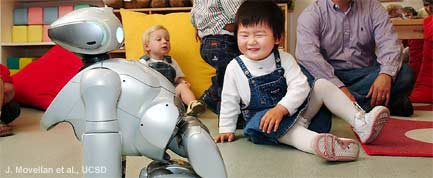
Humans revel in touch. Touch-spoiled babies grow up healthier; lovers can't keep their hands off each other; and people who master the subtle touch are perceived as friendlier.
Touch could also be key to making robots accepted by humans as social peers, scientists say.
On average, robots today can hold human interest for only about 10 hours, but in a new study, a humanoid robot dubbed QRIO (pronounced "curio") was accepted by human toddlers as "one of them" for 5 months before it was taken away.
The secret? QRIO was programmed to have a crude sense of touch.
"We put in this simple contingency where if the children touched the robot, the robot would giggle," said study leader Javier Movellan of the University of California, San Diego. "That completely changed everything."
The finding, detailed online in the Nov. 5 issue of the journal for the Proceedings of the National Academy of Sciences, suggests robots don't have to look human to be accepted as one.
Robot child
Sign up for the Live Science daily newsletter now
Get the world’s most fascinating discoveries delivered straight to your inbox.
In the study, QRIO was introduced into a classroom of toddlers aged 18 months to 24 months. Children of this age group were chosen because they have no preconceived notions of robots and they communicate using touch as much as speech.
"The children accepted the presence of QRIO very well," Movellan told LiveScience. "There were a few children who were very interested but maintained distance. Over time, the relationship between children and QRIO evolved positively."
In phase I of the experiment, which lasted 27 sessions, QRIO was instructed to interact with the children using its full behavioral repertoire, which included head-turning, dancing and giggling. At first, the children would touch the robot on its face, but as they warmed to him, the majority of their touches were to its hands and arms—a pattern the children also displayed toward each other.
During phase II, which lasted 15 sessions, QRIO ignored the children's touches and danced throughout the session. "At that point, the [children] quickly lost interest," Movellan said.
When QRIO's ability to respond to touch and giggle were returned for three sessions in phase III, the children became friendly with the robot again. When robot's batteries died and it laid on the floor, some of the children cried. Others put a blanket over him and said, "nigh-nigh."
Like R2-D2
QRIO's success shows robots don't need to be entirely "life-like" to be successful, Movellan said. QRIO stood only about 2-feet (58 centimeters) tall, and its only resemblance to a human was that it had two hands and walked on two legs. And because speech-recognition technology doesn't work well in noisy environments, QRIO couldn't even talk.
"QRIO was kind of like R2-D2 [in "Star Wars"]," Movellan said. "It expressed emotions but not speech."
The ability to respond to touch is relatively easy to program into robots, Movellan said. "We had things like computer vision in the robot, and touch was the easiest thing," he said. "And it turned out to be the most important to get things going."
Adults weren't completely immune to QRIO's charms either, Movellan said. Even though the researchers said it was OK, teachers supervising the children would try to stop them when they poked QRIO in the eye. However, the teachers did not try to stop the children when they poked the eyes of an inanimate toy robot, named "Robby," that looked like QRIO.
QRIO "elicits these feelings on us," Movellan said. "First of all, we feel badly if the children are doing that to the robot. And secondly, there is this problem that if you don't tell the children not to treat the robot as another person, they may actually be learning bad things about how to treat other people."
- VIDEO: Giggly Robot
- LiveScience.com: Vote for your favorite Real Robots
- Helpful Robot Alters Family Life









